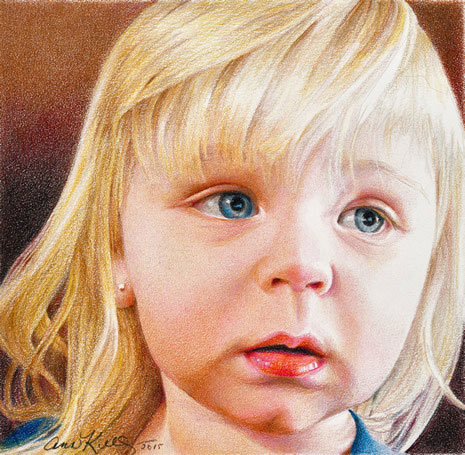Control Yourself! Or Your Colored Pencil, at Least

As little babes, we pick up our first crayons and pencils around the same time that our parents began teaching us how to use a spoon or soft-tipped fork with which to eat. It becomes second nature. So it seems only natural that learning how to draw with colored pencils is a wonderful way for beginning artists to dip their toes into creating art. You don’t need a plethora of art materials, and you’re already familiar with how they work, to an extent.

You may have seen colored pencil art that could be mistaken for another media because of its smooth gradients or minute details, but how do artists maintain control of the tool and create that look? They do so with an arsenal of methods. Ann Kullberg explains the helpful colored pencil technique of scumbling below.
“The scumbling technique offers a lot of control and allows for a very smooth, even application that shows no strokes at all,” Ann says. “Use a very sharp pencil, turning it often to keep the point sharp, and apply the smallest circular motion you can muster very, very lightly. Slightly overlap here and there. If you use too much pressure, you’ll burnish the paper (flatten its tooth, making it smooth). If your circular motion is too large, you’ll get anything but a smooth look. Think circular motion, not circles, when using this technique. Scumbling is slow, slow, slow and is definitely a technique only for the very patient artist. For some, it will seem tedious, but others will find it soothing and meditative!”
Kullberg is also featured in a series of pattern packets that focus on drawing with colored pencil (click here to see more details and get yours today). You’ll be amazed with how far you’ll be able to take your colored pencil art. Also, scroll down to find out why you should use a hard surface, how to find the right pencil-stroke length and how to get even lines.
Happy drawing,
Cherie

Colored Pencil Tips: A Q&A with Ann Kullberg
Q: Why is it necessary to always work on a hard surface?

A: It’s not necessary, but be aware that if you’re working on a soft surface (such as a sketch pad) you lose some control because of the give of the surface. You’ll also have a harder time getting strong, dark values since a soft surface won’t allow you to use as much pressure as a hard surface will.
Q: How do I know if my pencil strokes are the right length?
A: If you’re trying to cover an area with a flat, even coat and it looks choppy, your strokes are probably too short. If you’re having trouble keeping your lines straight and they’re curving slightly, your strokes are probably too long. The stroke length should feel natural to you.
Q: I’m trying to create a light, airy quality but every once in a while I get a darker line, even though I’m sure I haven’t increased my pressure. What am I doing wrong?
A: If you haven’t increased your pressure but you suddenly get a darker line, I’m guessing it’s either because you’ve just sharpened your pencil or you’ve turned it. Once you sharpen (or turn) a dull point, it immediately gets into more valleys, so with less paper showing, it looks darker.
~Ann Kullberg






It is incredible that an artist can get such a crisp and beautiful detail using a colored pencil. Honestly, I had to look very closely to the portrait shown and still didn’t realize it was truly colored pencil work. Recently, I got to review a high quality colored pencil set with triangle shaped pencils from Ariana’s Art. It’s one of the best I’ve ever tried. The set is above and beyond what you would expect from the little 24 packs you can get the the kids at Walmart! Actually, that review gave me the impetus to look for instructional materials to learn how to best use these pencils and other media and that’s how I found artistsnetwork. I’ll be checking out your online tutorials for sure.